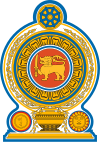Parliament of the Democratic Socialist Republic of Sri Lanka ශ්රී ලංකා ප්රජාතාන්ත්රික සමාජවාදී ජනරජයේ පාර්ලිමේන්තුව இலங்கை நாடாளுமன்றம் | |
|---|---|
| 17th Parliament | |
 | |
| Type | |
| Type | |
| History | |
| Founded | 7 September 1978 |
| Preceded by | National State Assembly |
| Leadership | |
TBD | |
TBD, SJB | |
Kushani Rohanadeera since 23 May 2023 | |
| Structure | |
| Seats | 225 |
 | |
Political groups | Government (159)
Opposition (66) |
Length of term | 5 years |
| Elections | |
| Open list proportional representation | |
First election | 15 February 1989 |
Last election | 14 November 2024 |
Next election | 2029 |
| Meeting place | |
 | |
| Sri Lankan Parliament Complex Sri Jayawardenepura Kotte Sri Lanka | |
| Website | |
| www | |
| Constitution | |
| Constitution of Sri Lanka | |
| This article is part of a series on the |
| Politics of Sri Lanka |
|---|
 |
The Parliament of the Democratic Socialist Republic of Sri Lanka (Sinhala: ශ්රී ලංකා පාර්ලිමේන්තුව Shri Lanka Parlimenthuwa, Tamil: இலங்கை நாடாளுமன்றம் Ilaṅkai nāṭāḷumaṉṟam) is the supreme legislative body of Sri Lanka. It alone possesses legislative supremacy and thereby ultimate power over all other political bodies in the island.[1][2] It is modeled after the British Parliament. The 17th Parliament of Sri Lanka will convened on 21 November 2024.[3]
It consists of 225 members known as Members of Parliament (MPs). Members are elected by proportional representation for five-year terms, with universal suffrage.
The President of Sri Lanka has the power to summon, suspend, prorogue, or terminate a legislative session and to dissolve the Parliament. The President can dissolve Parliament only after the lapse of 2+1⁄2 years or if a 2⁄3 majority of the Members of Parliament requests dissolution. The action of the president to either suspend or dissolve the Parliament is subject to legal scrutiny of the Supreme Court of Sri Lanka. The Speaker or, in his absence, the Deputy Speaker and Chairman of Committees or the Deputy Chairman of Committees, presides over Parliament.
- ^ "Welcome to GOV.LK :: Government". www.gov.lk. Retrieved 19 November 2024.
- ^ "Constitution of the Democratic Socialist Republic of Sri Lanka with Amendments incorporated up to the 21st Amendment" (PDF). www.parliament.lk. Retrieved 19 November 2024.
- ^ Walpola, Thilina (18 November 2024). "New Parliament meets on 21 Nov". The Island. Retrieved 19 November 2024.